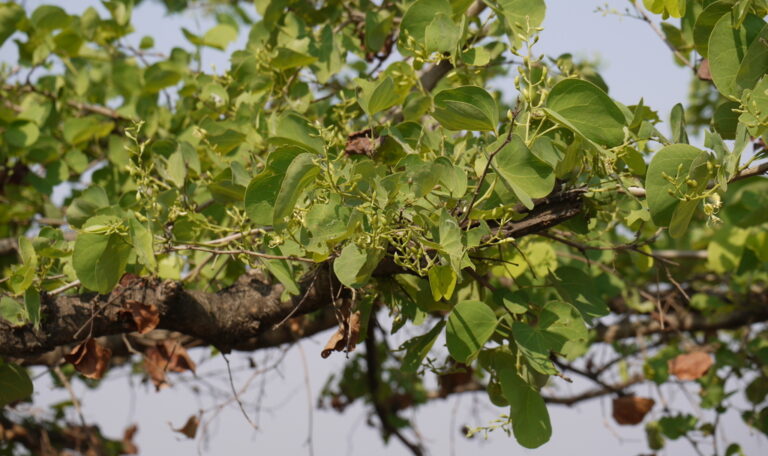Botanical name: Bauhinia racemosa| Hindi: कठमूली | Marathi: आपटा | English: Bidi Leaf Tree
About
The Bidi Leaf Tree, known as कठमूली in Hindi and Bauhinia racemosa scientifically, is a small yet captivating tree growing up to 5 meters tall. Its unique leaves, resembling cow hooves or split spoons, stand out with their broader width than length. This feature distinguishes it from other Bauhinia species. The leaves range from green to yellowish-green, adding to its charm. During spring, clusters of small, greenish-white flowers grace the branches, attracting pollinators. Later, flat, curved pods develop, containing several brown seeds. The tree thrives in tropical and subtropical regions, adapting to dry and slightly moist environments.
Interesting Facts

Medicinal Uses: Traditional medicine utilizes various parts of the Bidi Leaf Tree. Bark, leaves, and flowers are attributed with anti-inflammatory, anti-microbial, and wound-healing properties. Some believe it aids in digestive issues and skin conditions. However, scientific evidence is limited, and potential side effects exist. Consulting a healthcare professional before using any part of the plant medicinally is crucial.

Culture & Tradition: The Bidi Leaf Tree holds deep cultural significance in India. In Maharashtra, it’s associated with Lord Shiva and used in religious offerings during festivals like Dussehra. Its leaves are exchanged symbolically as “gold” due to their shiny yellow-green color. In Ayurveda, it’s considered a “Kaphahara,” balancing the Kapha energy in the body. Its presence in homes signifies well-being and prosperity.

Environmental Impact: The Bidi Leaf Tree holds deep cultural significance in India. In Maharashtra, it’s associated with Lord Shiva and used in religious offerings during festivals like Dussehra. Its leaves are exchanged symbolically as “gold” due to their shiny yellow-green color. In Ayurveda, it’s considered a “Kaphahara,” balancing the Kapha energy in the body. Its presence in homes signifies well-being and prosperity.

Food & Culinary usage: While the main use of the Bidi Leaf Tree lies in its leaves used for wrapping bidis (tobacco rolls), some communities have unique culinary practices. Young leaves are sometimes consumed raw or cooked in curries due to their slightly bitter taste. The flowers are occasionally used in pickles or chutneys. However, caution is advised due to potential toxicity and the prevalence of alternative, safer edible leaves.

